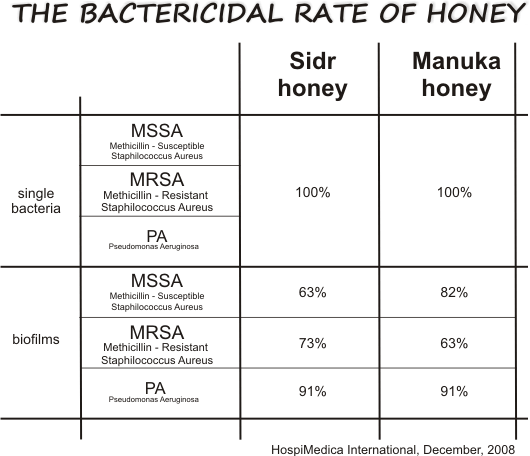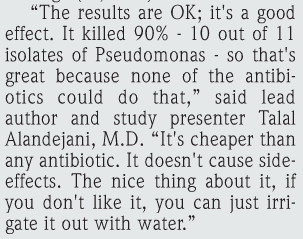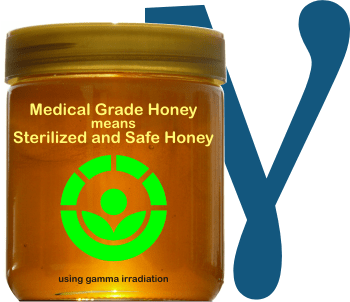The latest news bring back some old knowledge: Honey is antimicrobial. And yes, it can also kill antibiotic resistant bacteria, germs, microbes, superbugs, or whatever the name you choose for them.
Microbes are like people: good and bad. We all know about the good probiotics – the friendly bacteria in our guts. But we should also know that bacteria are everywhere in our body, not only the gut. We could not hear, smell or everything else without them. We cannot live without them. While, of course, the reciprocal is not valid.
The bad microbes (referring more at bacteria), are causing malfunctions. The body knows how to fight them, but sometimes they are so strong, that we need to help our immune system to win the battle.
Honey has always been a trustful friend in these situations. It helps us in two different ways:
1. By stimulating our immune system and having an anti-inflammatory and prebiotic activity (the food for the our friendly bugs – probiotics).
2. By directly inhibiting the growth of microorganisms and fungi.

Honey is a complex substance, containing up to 800 compounds and because of this complexity it has been difficult to pinpoint exactly how it kills bacteria. Joe Traynor, author of “Honey, the gourmet medicine”, describes 4 properties of honey that makes it anitimicrobial:
1. Honey’s content of water is very low.
This is called hyperosmolarity. The water content is between 18% and 20% or even lower. When honey comes in contact with other tissues, it literally absorbs the water from the cells, thus killing them.
2. Honey is very acidic.
The pH of honey varies between 3.3 and 4.6. The exceptions are: chestnut honey (with a relatively high pH, between 5 and 6) and honeydew honey, which has a higher mineral content (pH between 4.5 and 6.5).
Even more, honey is a buffer, meaning that it won’t change its pH when small quantities of acids or bases are added. This buffer capacity is due to the presence of phosphates, carbonates and other mineral salts.
Honey is more acidic that most foods and some acids, and a low acidity inhibits the growth of most bacteria.
3. Honey generates hydrogen peroxide.
What is hydrogen peroxide?
It’s a disinfectant used for decades in our medicinal world. But it is unstable in the presence of air and light, which makes in difficult to store and use. And in high concentration it can become toxic to human tissues.
How is it made in honey?
Honey contains an enzyme called oxidase. It was added by the bees to the pollen in order to turn it into honey. This enzyme will break the glucose down into gluconic acid and hydrogen peroxide.
However, this doesn’t happen in pure honey, because of its low pH (it should be of at least 5.5) and low sodium quantity (it should be of at least 2,300 ppm, and not of 20 to 40 ppm, how it is found in honey).
But when honey is applied on a wound, burn or other skin infection, the serum from the tissues dilutes the honey and raises its pH, adding sodium and ultimately activating the enzyme oxidase. Thus, small quantities of hydrogen peroxide are produced little by little directly on the wound, making honey a perfect, slow-release antimicrobial product for treating wounds.
Conclusion?
The hydrogen peroxide is not contained in the honey. It is produced in contact with the wound.
Yet, we should know that not all honeys have the capacity of producing it. There are some honeys that contain a different enzyme, called catalase, which neutralizes hydrogen peroxide. Those honeys have a less antimicrobial activity.
4. Honey contains floral factors from the nectar.
Each flower has its own therapeutic properties, and they will be all gathered in honey, through the pollen and nectar.
Such a therapeutic ingredient was found in Manuka bush from New Zealand and Australia (aka leptospermum bush), called MGO -methylglyoxal. The quantity of MGO found in Manuka Honey is expressed in UMF – Unique Manuka Factor. (link to the page “I want to buy manuka honey. What is UMF 16, MGO 400, Active?)
In 2008, Professor Thomas Henle (Head of the Institute of Food Chemistry at the Technical University of Dresden) was publishing a study made on 40 samples of honeys and Manuka Honey. The results showed that the level of MGO in Manuka, were 1,000 times higher that in the other honeys. Which should be taken very seriously, because MGO is highly toxic to the cells of the body. This is the reason for which, until further research, Manuka Honey is safely recommended only for external use. And in this field, it is the master of all healers.
Manuka is thus considered to have the strongest antibacterial properties, but more studies bring evidence that there are other honeys with similar antibacterial activity. Mostly of darker color.
Here are the most most effective honeys agains microbes, according to Stefan Bogdanov, (Switzerland, Muhlethurnen – PhD, the founder of the International Honey Commission):
Honey with HIGH antibacterial activity:
blueberry, buckwheat, chestnut, cotton, fire-weed, heather, jarrah, honeydew, linen vine, manuka, red gum, revamil, tualang, ulmo
Honey with INTERMEDIATE antibacterial activity:
eucalyptus, clover, lavender, linden, rape, rhododendron, rosemary, thyme, tupelo;
Honey with LOW antibacterial activity:
acacia, Christmas vine, borage, lucerne (alfalfa), orange.
All the other constituents of honey, recently identified, confirm the powerful antimicrobial properties of honey. They include: antioxidants, polyphenols, enzymes and peptides.
![]() that on a person’s hand there are as many microbes as people on the entire planet?
that on a person’s hand there are as many microbes as people on the entire planet?
Here are the microbes that were researched to be sensitive to honey, as reported by Dr. Peter Molan, professor of biochemistry at Waikato University, New Zealand, in his book “The antibacterial activity of honey”.
| NAME OF THE PATHOGEN | INFECTION CAUSED |
| Bacillus anthracis | anthrax |
| Corynebacterium diphtheriae | diphtheria |
| Escherichia coli | diarrhea, septicaemia, urinary infections, wound infections |
| Haemophilus influenzae | ear infections, meningitus, respiratory infections, sinusitis |
| Klebsiella pneumoniae | pneumonia |
| Mycobacterium tuberculosis | tuberculosis |
| Proteus sp. | septicaemia, urinary infections |
| Salmonella sp. | diarrhoea |
| Salmonella cholerae-suis | septicaemia |
| Salmonella tyohi | typhoid |
| Salmonella typhimurium | wound infections |
| Serrata marcescens | septicaemia, wound infections |
| Shigella sp. | dysentery |
| Staphylococcus aureus | abscesses, boils, carbuncles, impetigo, wound infections |
| Streptococcus faecalis | urinary infections |
| Streptococcus mutans | dental carries |
| Streptococcus pneumoniae | ear infections, meningitis, pneumonia, sinusitis |
| Streptococcus pyogenes | ear infections, impetigo, puerperal fever, scarlet fever, sore throat, wound infections |
| Vibrio choleriae | cholera |
| Actin. pyoneges, Kleb.Pneum. Noc. Asteroids, Staph aureus, Streptoc agal., dysgal. |
mastitis |
| Epiderm floccosum, Microsp. canis, M. gypseum, Trichoph rubrum, T. tonsurans, T. mentagr. var. |
tinea |
| E coli, Salmonella, Shigella, Vibrio, Hel pylori |
peptic ulcer |
Scientific research?
The first scientific documents we have today, refer to the research made by the Dutch scientist Van KETELl in 1892 (cited by Dustmann), followed by Sackett in 1919.
In 1962 three doctors in Eastern Regional Research Laboratory, Philadelphia, were writing about “The Identification of Inhibine, the Antibacterial Factor in Honey as Hydrogen Peroxide and its origin in a Honey Glucose-Oxidase System”.
In 1979 J.H. DUSTMANN wrote “Antibacterial Effect of Honey”.
In 1992 Molan, wrote “The antibacterial activity of honey” Bee World 73, and he was followed by Al-Waili et al, in 2011 (Honey and Microbial Infections, A review supporting the use of honey for microbial control, Journal of Medicinal Food 14), and so many other clinical trials and articles nowadays.
Killing Pseudomonas Aeruginosa and Staphylococcus Aureus!
HospiMedica International was publishing in December 2008, an article entitled “Bacterial Cause of Chronic Sinusitis Eradicated by Honey”.
Researches of the University of Ottawa tested in the laboratory the bactericidal effects of different honey against both single bacteria and biofilm forms. The targetted bacteria were Pseudomonas Aeruginosa and Staphylococcus Aureus, known to be the main factors of causing chronic rhinosinusitis and other inflammations of sinuses and mucosa.
For the research they used Manuka Honey (from New Zealand) and Sidr Honey (from Yemen).
The other 2 honeys they used were from clover and buckwheat (from Canada), but they proved to be ineffective against the biofilms. Both honeys were successful:

 The researchers said these results will be followed by an animal study, which will check the safety of using a honey-water solution to irrigate the nose. The alternative medicine has probably already come with some solutions. After presenting the results at the American Academy of Otolaryngology-Head and Neck Surgery Foundation, their words were those from the picture:
The researchers said these results will be followed by an animal study, which will check the safety of using a honey-water solution to irrigate the nose. The alternative medicine has probably already come with some solutions. After presenting the results at the American Academy of Otolaryngology-Head and Neck Surgery Foundation, their words were those from the picture:
Ever since “the scientific research” was almost invented, people tried to explain how honey works and how to use it for better benefits. Today there are so many institutions and scientists researching it, that are impossible to summarize them. We follow the clinical trials that are made public and read the latest books on the subject.
Like this book found on Amazon: The New Honey Revolution: Restoring the Health of Future Generations. A really good book that I recommend, which can be found in kindle version at a very good price. It’s easy to read, based on lots of real stories about people who have discovered, on their own skin, how good honey is for their health. About all the transformations and all life changes that followed after that. A revolutionary book, as it says itself.
Another very good book describing the uses of honey as medicine, showing how beneficial honey is for wounds, burns, eyes, infants, stomach problems, skin and more, is Honey: The Gourmet Medicine. Unfortunately, it can be found only in paperback, as it was written in 2002.
Honey is not new. It is mentioned in every religious book on this planet. It dates back to before 2000 BC in Egyptian writings. New is only the way to look at it.
Related posts:
• What gives honey its antimicrobial power?
• Onion and honey: a natural remedy for bacterial infection!
• Is Manuka Honey safe to eat?
• Sidr honey benefits for health
• Tualang honey benefits for health
![]()
References and further reading:
The Identification of Inhibine, the Antibacterial Factor in Honey as Hydrogen Peroxide and its origin in a Honey Glucose-Oxidase Systemhttp;
Peter C Molan: The antibacterial activity of honey ;
J.H. DUSTMANN: Antibacterial Effect of Honey;
Ron Fessenden: The New Honey Revolution;
Joe Traynor: Honey: The Gourmet Medicine;
HospiMedica International: Bacterial Cause of Chronic Sinusitis Eradicated by Honey;
Stefan Bogdanov: Bee Product Science, February 2014
bacteria picture (from the slider) credit renjith krishnan, via FreeDigitalPhotos.net;
bacteria picture (from the fetaured picture) credit jscreationzs via FreeDigitalPhotos.net




